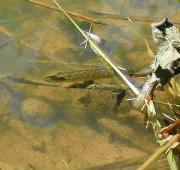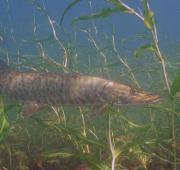 The pike is a large species of freshwater fish, natively found in North America and across Eurasia. There are five recognised species of this large predatory fish which are the American pickerels, the Northern Pike, the Muskellunge, the Chain Pickerel and the Amur pike. Pikes are also one of the world's oldest fish, thought to have been found on earth for the past 65 million years.
The pike is a large species of freshwater fish, natively found in North America and across Eurasia. There are five recognised species of this large predatory fish which are the American pickerels, the Northern Pike, the Muskellunge, the Chain Pickerel and the Amur pike. Pikes are also one of the world's oldest fish, thought to have been found on earth for the past 65 million years. Pike are most commonly found in large bodies of deep, slow-moving water such as lakes, rivers and occasionally in large streams. Pike inhabit areas where there is plenty of cover from the reeds, where they are able to lurk until dinner swims past. Pike are found in North America, Canada, across Europe and into parts of western Asia.
Pike are most commonly found in large bodies of deep, slow-moving water such as lakes, rivers and occasionally in large streams. Pike inhabit areas where there is plenty of cover from the reeds, where they are able to lurk until dinner swims past. Pike are found in North America, Canada, across Europe and into parts of western Asia.


Although young pike may have the odd nibble on plants. pike generally have a purely carnivorous diet. Adult pike primarily feed on smaller fish in the water that the pike is able to ambush from it's hiding place amongst the aquatic weeds. Pike also hunt a number of other animals in the water including amphibians like frogs and toads and invertebrates such as snails and spiders.
Due to their large size and naturally aggressive nature, the pike tends to be the most dominant predator within it's environment and adult pike therefore have very few predators in the wild. Smaller pike however are preyed upon by mainly land-dwelling animals from foxes to large birds of prey.
As a rule of thumb, the heavier the pike, the more likely it is that the fish is a female as male pike rarely attains weights of 10 pounds or more. A large female pike can lay up 200,000 eggs at once although this number is often much lower, but is entirely dependent on the size of the fish. Female pike usually spawn in the spring when the weather begins to warm, meaning that the pike fry (babies) have the longest time possible to develop before the cold winter sets in.
Today, although still common across much of it's native range, pike populations are being affected on both the North American and European continents mainly due to over-fishing and chemical pollutants in the water.

